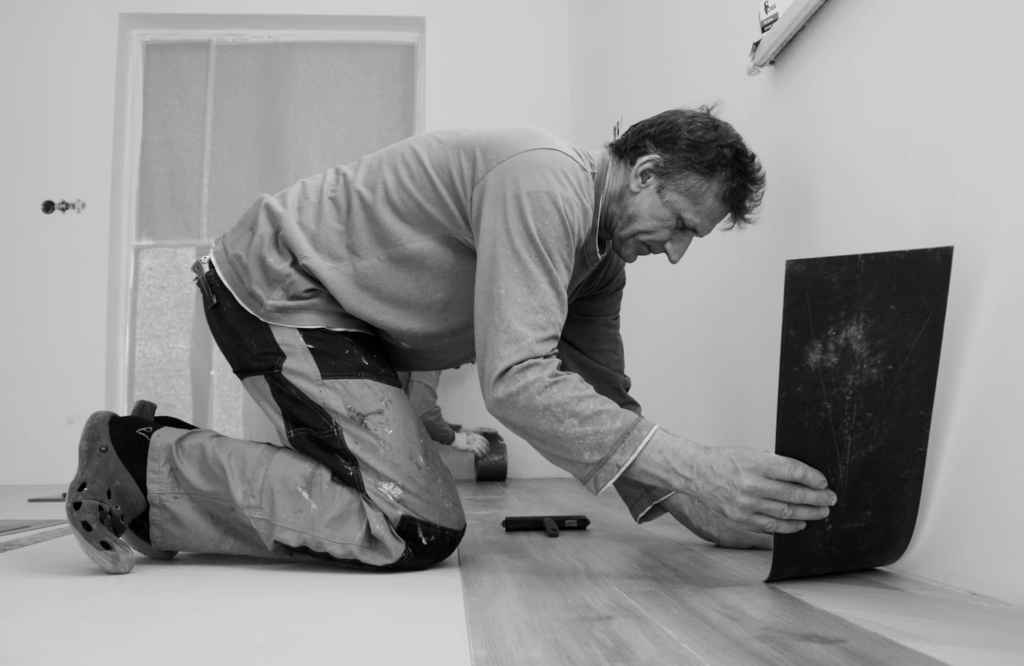Ready to install hardwood floors that look absolutely stunning?
Installing hardwood flooring is one of the best things you can do to upgrade your home. It instantly transforms your space and adds serious value to your property.
Here’s the thing…
Hardwood installation is way simpler than most people expect. It just requires following the right process. This applies whether you’re installing hardwood floors yourself or finding a flooring specialist for installation services and quotes. Knowing the step-by-step process will save you time, money, and headaches.
Right now the flooring industry is booming. The global market hit $335.91 billion in 2023 and growing rapidly year-over-year. There are tons of new flooring options and installation techniques, but also tons of ways to screw up if you don’t know what you’re doing.
The good news is that you don’t have to get lost in all of this. Here’s exactly what the right process looks like.
What you’ll discover:
- Essential Prep Work That Makes or Breaks Your Project
- The Complete Installation Process Step-by-Step
- Tools and Materials You Actually Need
- Pro Tips to Avoid Costly Mistakes
- When to Call in the Professionals
Essential Prep Work That Makes or Breaks Your Project
Let’s start with what most people get wrong about hardwood installation…
They completely skip the prep work.
BIG mistake.
Preparation is literally 70% of a successful hardwood floor installation. Cut corners and you’ll end up living with squeaky, uneven, or damaged floors for years to come.
Check Your Subfloor
Your subfloor is the foundation of your hardwood floor. It needs to be completely level, dry, and structurally sound. Any imperfections in your subfloor will be amplified once your new flooring is installed.
Walk around on your subfloor and listen for squeaks, cracks, or soft spots. Use a 4-foot level to check for high and low spots in the floor. Anything more than 3/16 of an inch over a 10-foot span needs to be addressed.
Moisture Testing Is Critical
Moisture is hardwood’s #1 enemy. Test the moisture level of both your subfloor and the hardwood planks you’re installing with a moisture meter.
The difference in moisture levels between the two should never be greater than 4%. Otherwise you risk having problems with gaps, cupping, or buckling in the future.
Acclimate Your Flooring
Most hardwood flooring needs to acclimate to the environment of your home before it’s installed. This allows the planks to expand and contract at the same rate as the ambient conditions of your space.
Check with your manufacturer, but generally expect hardwood to acclimate for 48-72 hours before installation. Some require up to a full week.
Stack the flooring with spacers between planks in the room where they’ll be installed. This allows air to circulate around all sides of the planks so they properly adjust to their environment.
The Complete Installation Process Step-by-Step
Ready to dive into the actual installation? Here’s exactly how to do it right…
Step 1: Plan Your Layout
Find the center of your room and snap chalk lines from wall to wall. This will give you a clear starting point and make it easier to install nice, straight rows.
Pro tip: Always start installation along the longest, straightest wall in the room. Makes for a much better looking finished floor.
Step 2: Install Your First Row
This row sets the tone for the entire project, so take your time. Measure the distance from your starting wall and cut your first plank if necessary.
Don’t forget to leave a 1/2 inch expansion gap along all walls. This will be covered by baseboards later.
Step 3: Work Row by Row
Here’s where the magic happens…
Install each new row by fitting the tongue of the new plank into the groove of the previous row. If you’re nailing solid hardwood, nails go through the tongue at a 45-degree angle.
Secret to professional results?
Stagger your joints by at least 6 inches between rows. This creates a natural, strong pattern that looks great and performs better.
Step 4: Handle Obstacles and Cuts
Every room has obstacles. Heating vents, door jambs, irregular walls… these all require special attention.
For door jambs, make sure to use an undercut saw to cut the bottom of the casing. This lets your flooring slide right underneath for a nice, finished look.
Step 5: Install the Final Rows
The last few rows are always the most challenging. Expect to have to rip planks to width and use a pull bar to snug them tight. 
Measure twice, cut once. Mistakes on these highly visible final planks are costly.
Tools and Materials You Actually Need
Don’t get overwhelmed by the massive lists of tools flooring contractors use. The truth is you really only need a few essentials:
Essential Tools:
- Miter saw or circular saw
- Pneumatic flooring nailer
- Moisture meter
- Chalk line
- Tape measure
- Pull bar and tapping block
- Safety glasses and hearing protection
Materials Beyond Flooring:
- Underlayment (if required)
- Flooring nails or staples
- Wood glue (for repairs)
- Transition strips
- Quarter round or shoe molding
The biggest mistake people make? Cheap tools. A decent pneumatic nailer alone can save you hours of work and deliver much better results.
Pro Tips to Avoid Costly Mistakes
Curious about the secrets that separate amateur installations from professional results?
Mix Your Bundles
Open up several boxes of flooring and mix planks from different bundles as you go. This helps the color variation look natural rather than patchy.
Check Your Work Constantly
Step back every few rows and check that everything looks straight and properly aligned. Small problems compound into big headaches if you don’t catch them early.
Don’t Rush the Finishing Touches
Take your time with transition strips, quarter round, and other trim pieces. This is where poor installation really shows up. Gaps around the perimeter, uneven transitions, sloppy trim work screams “DIY job.”
When to Call in the Professionals
Here’s the secret about DIY hardwood installation…
It is totally doable for many homeowners. But there are definitely cases where calling a pro makes sense.
Consider pros if:
- Subfloor needs major repairs
- Room layout is very complex
- You don’t have the proper tools
- Time is a major factor
Professional installation typically costs $4,726 on average for most homes, but you’re paying for speed, expertise, and warranty coverage.
Simple math:
If you make mistakes on a DIY job you often end up paying more to fix them than it would have cost to hire a pro from the start. Plus many flooring warranties require pro installation to remain valid.
Wrapping Up the Process
Successful hardwood floor installation really comes down to three things.
Proper preparation. Following the right process. And not rushing the details.
The actual process isn’t overly complicated. But there’s no shortcuts. Each step is dependent on the previous step being done correctly. Little problems early on compound as you go.
Whether you do this as a DIY project or hire professionals, knowing the complete process helps you get better results. You know what to expect, what questions to ask, how to spot issues before they become expensive problems.
Bottom line?
Take your time with the prep work, invest in quality tools, and don’t be afraid to call in help when you need it. Your floors will look better, last longer, and you’ll enjoy the process instead of fighting it.
Done right, hardwood flooring installation is one of the most rewarding home improvement projects you can tackle. The result is a beautiful, durable floor that adds value to your home for decades.

